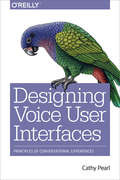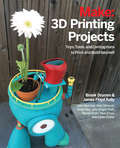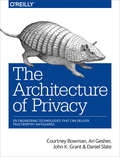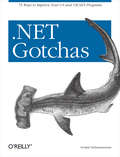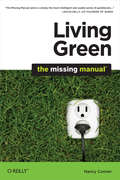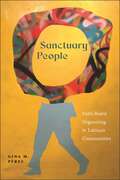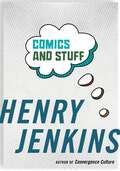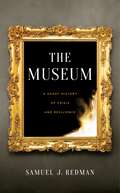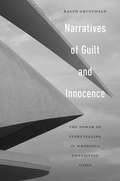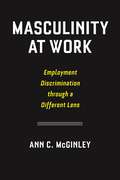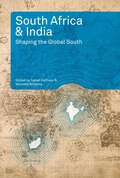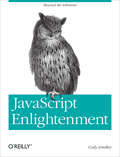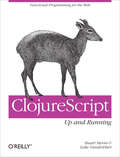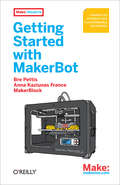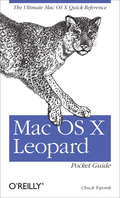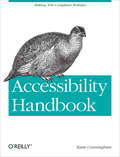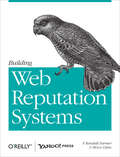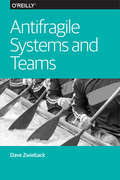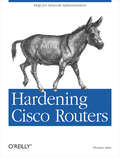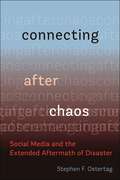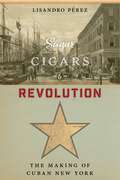- Table View
- List View
Designing Voice User Interfaces: Principles of Conversational Experiences
by Cathy PearlVoice user interfaces (VUIs) are becoming all the rage today. But how do you build one that people can actually converse with? Whether you’re designing a mobile app, a toy, or a device such as a home assistant, this practical book guides you through basic VUI design principles, helps you choose the right speech recognition engine, and shows you how to measure your VUI’s performance and improve upon it.Author Cathy Pearl also takes product managers, UX designers, and VUI designers into advanced design topics that will help make your VUI not just functional, but great.Understand key VUI design concepts, including command-and-control and conversational systemsDecide if you should use an avatar or other visual representation with your VUIExplore speech recognition technology and its impact on your designTake your VUI above and beyond the basic exchange of informationLearn practical ways to test your VUI application with usersMonitor your app and learn how to quickly improve performanceGet real-world examples of VUIs for home assistants, smartwatches, and car systems
3D Printing Projects: Toys, Bots, Tools, and Vehicles To Print Yourself
by James Floyd Kelly John Baichtal John Edgar Park Nick Ernst Caleb Cotter Brian Roe Steven Bolin Brook Drumm Rick WinscotEven if you've never touched a 3D printer, these projects will excite and empower you to learn new skills, extend your current abilities, and awaken your creative impulses. Each project uses a unique combination of electronics, hand assembly techniques, custom 3D-printed parts, and software, while teaching you how to think through and execute your own ideas. Written by the founder of Printrbot, his staff, and veteran DIY authors, this book of projects exemplifies the broad range of highly personalized, limit-pushing project possibilities of 3D printing when combined with affordable electronic components and materials. In Make: 3D Printing Projects, you'll:Print and assemble a modular lamp that's suitable for beginners--and quickly gets you incorporating electronics into 3D-printed structures.Learn about RC vehicles by fabricating--and driving--your own sleek, shiny, and fast Inverted Trike.Model a 1950s-style Raygun Pen through a step-by-step primer on how to augment an existing object through rapid prototyping.Fabricate a fully functional, battery-powered screwdriver, while learning how to tear down and reconstruct your own tools.Get hands-on with animatronics by building your own set of life-like mechanical eyes.Make a Raspberry Pi robot that rides a monorail of string, can turn corners, runs its own web server, streams video, and is remote-controlled from your phone.Build and customize a bubble-blowing robot, flower watering contraption, and a DIY camera gimbal.
The Architecture of Privacy: On Engineering Technologies that Can Deliver Trustworthy Safeguards
by Courtney Bowman Ari Gesher Elissa Lerner John K Grant Daniel SlateTechnology’s influence on privacy not only concerns consumers, political leaders, and advocacy groups, but also the software architects who design new products. In this practical guide, experts in data analytics, software engineering, security, and privacy policy describe how software teams can make privacy-protective features a core part of product functionality, rather than add them late in the development process.Ideal for software engineers new to privacy, this book helps you examine privacy-protective information management architectures and their foundational components—building blocks that you can combine in many ways. Policymakers, academics, students, and advocates unfamiliar with the technical terrain will learn how these tools can help drive policies to maximize privacy protection.Restrict access to data through a variety of application-level controlsUse security architectures to avoid creating a single point of trust in your systemsExplore federated architectures that let users retrieve and view data without compromising data securityMaintain and analyze audit logs as part of comprehensive system oversightExamine case studies to learn how these building blocks help solve real problemsUnderstand the role and responsibilities of a Privacy Engineer for maintaining your privacy architecture
.NET Gotchas: 75 Ways to Improve Your C# and VB.NET Programs
by Venkat SubramaniamLike most complex tasks, .NET programming is fraught with potential costly, and time-consuming hazards. The millions of Microsoft developers worldwide who create applications for the .NET platform can attest to that. Thankfully there's now a book that shows you how to avoid such costly and time-consuming mistakes. It's called .NET Gotchas.The ultimate guide for efficient, pain-free coding, .NET Gotchas from O'Reilly contains 75 common .NET programming pitfalls--and advice on how to work around them. It will help you steer away from those mistakes that cause application performance problems, or so taint code that it just doesn't work right.The book is organized into nine chapters, each focusing on those features and constructs of the .NET platform that consistently baffle developers. Within each chapter are several "gotchas," with detailed examples, discussions, and guidelines for avoiding them. No doubt about it, when applied, these concise presentations of best practices will help you lead a more productive, stress-free existence.What's more, because code examples are written in both VB.NET and C#, .NET Gotchas is of interest to more than 75 percent of the growing numbers of .NET programmers. So if you're a .NET developer who's mired in the trenches and yearning for a better way, this book is most definitely for you.
Living Green: The Missing Manual (Missing Manual)
by Nancy ConnerTaking care of the earth is more important than ever, but the problems we're facing can seem overwhelming. Living Green: The Missing Manual helps make earth-friendly decisions more manageable by narrowing them down to a few simple choices. This all-in-one resource is packed with practical advice on ways you can help the environment by making simple changes in your home routine, work habits, and the way you shop and get around town. You don't have to embark on a radical new lifestyle to make a difference. Living Green: The Missing Manual shows you how small changes can have a big impact. With this book, you will:Learn how to make your home energy efficient and free of toxic chemicalsDiscover how to reduce waste, repurpose and recycle, and do more with lessBuild and remodel earth-friendly homes with new techniques and materialsLearn tips for buying organic food and what it takes to grow your ownGet helpful information on fuel-efficient cars, including hybrid and electric modelsMake your workplace greener and more cost-effective -- from changes at your desk to suggestions for company-wide policiesExplore how to choose renewable energies, such as wind and solar powerThe book also provides you with ways to connect with like-minded people and offers a survey of exciting new green technologies. Learn how you can help the planet with Living Green: The Missing Manual.
Sanctuary People: Faith-Based Organizing in Latina/o Communities
by Gina M. PérezExplores ways faith communities offer protection and services for Latina/o communitiesThe New Sanctuary Movement is a network of faith-based organizations committed to offering safe haven to those in danger, often in churches, often outside the law, and often at risk to themselves. The practice of sanctuary, with its capacity to provide safety, shelter, and protection to society's most vulnerable, gained significant prominence after the 2016 presidential election and the ushering in of particularly harsh anti-immigration policies.Since 2017, Ohio has had some of the highest numbers of public sanctuary cases in the nation. Sanctuary People explores these sanctuary practices in Ohio and locates them in broader local and national efforts to provide refuge and care in the face of the challenges facing Latina/o communities in a moment of increased surveillance, migrant detention, displacement, and economic and social marginalization. Pérez argues for a conceptualization of sanctuary that is capacious, placing support of Puerto Ricans displaced in the wake of Hurricane Maria within the broader practices of sanctuary and expanding our understandings of the movement that addresses the precarious conditions of Latinas/os beyond migration status.Based on four years of ethnographic research and interviews at the local, state, and national levels, Sanctuary People offers a compelling exploration of the ways in which faith communities are creating new activist strategies and enacting new forms of solidarity, working within the sometimes conflicting ideological space between religion and activism to answer the call of justice and live their faith.
Comics and Stuff
by Henry JenkinsConsiders how comics display our everyday stuff—junk drawers, bookshelves, attics—as a way into understanding how we represent ourselves nowFor most of their history, comics were widely understood as disposable—you read them and discarded them, and the pulp paper they were printed on decomposed over time. Today, comic books have been rebranded as graphic novels—clothbound high-gloss volumes that can be purchased in bookstores, checked out of libraries, and displayed proudly on bookshelves. They are reviewed by serious critics and studied in university classrooms. A medium once considered trash has been transformed into a respectable, if not elite, genre.While the American comics of the past were about hyperbolic battles between good and evil, most of today’s graphic novels focus on everyday personal experiences. Contemporary culture is awash with stuff. They give vivid expression to a culture preoccupied with the processes of circulation and appraisal, accumulation and possession. By design, comics encourage the reader to scan the landscape, to pay attention to the physical objects that fill our lives and constitute our familiar surroundings. Because comics take place in a completely fabricated world, everything is there intentionally. Comics are stuff; comics tell stories about stuff; and they display stuff.When we use the phrase “and stuff” in everyday speech, we often mean something vague, something like “etcetera.” In this book, stuff refers not only to physical objects, but also to the emotions, sentimental attachments, and nostalgic longings that we express—or hold at bay—through our relationships with stuff.In Comics and Stuff, his first solo authored book in over a decade, pioneering media scholar Henry Jenkins moves through anthropology, material culture, literary criticism, and art history to resituate comics in the cultural landscape. Through over one hundred full-color illustrations, using close readings of contemporary graphic novels, Jenkins explores how comics depict stuff and exposes the central role that stuff plays in how we curate our identities, sustain memory, and make meaning. Comics and Stuff presents an innovative new way of thinking about comics and graphic novels that will change how we think about our stuff and ourselves.
The Museum: A Short History of Crisis and Resilience
by Samuel J. RedmanCelebrates the resilience of American cultural institutions in the face of national crises and challengesOn an afternoon in January 1865, a roaring fire swept through the Smithsonian Institution. Dazed soldiers and worried citizens could only watch as the flames engulfed the museum’s castle. Rare objects and valuable paintings were destroyed. The flames at the Smithsonian were not the first—and certainly would not be the last— disaster to upend a museum in the United States. Beset by challenges ranging from pandemic and war to fire and economic uncertainty, museums have sought ways to emerge from crisis periods stronger than before, occasionally carving important new paths forward in the process. The Museum explores the concepts of “crisis” as it relates to museums, and how these historic institutions have dealt with challenges ranging from depression and war to pandemic and philosophical uncertainty. Fires, floods, and hurricanes have all upended museum plans and forced people to ask difficult questions about American cultural life. With chapters exploring World War I and the 1918 influenza pandemic, the Great Depression, World War II, the 1970 Art Strike in New York City, and recent controversies in American museums, this book takes a new approach to understanding museum history. By diving deeper into the changes that emerged from these key challenges, Samuel J. Redman argues that cultural institutions can—and should— use their history to prepare for challenges and solidify their identity going forward. A captivating examination of crisis moments in US museum history from the early years of the twentieth century to the present day, The Museum offers inspiration in the resilience and longevity of America’s most prized cultural institutions.
Narratives of Guilt and Innocence: The Power of Storytelling in Wrongful Conviction Cases
by Ralph Grunewald2023 Co-Winner of the Herbert Jacob Book Prize, given by the Law and Society AssociationIllustrates how the power of narrative influences how police, prosecutors, juries, and judges constructlegal realityWrongful convictions have been studied primarily through the lenses of law, psychology, and the social sciences. Though scholarship has established canonical factors that help explain why the innocent are convicted, a very simple question has not been answered: How is it possible that prosecutors can convince juries and themselves of the guilt of an innocent defendant, often even against strong exculpatory evidence? Narratives of Guilt and Innocence seeks to address this crucial question by highlighting the narrative blueprint of a given criminal justice system and then how the power of narrative influences how police, prosecutors, juries, and judges construct legal reality and the evidence for it. That law and storytelling are connected is a common trope, but we know surprisingly little about the intricate role storytelling plays in criminal cases and wrongful convictions in particular.This book questions the effectiveness of the adversarial contest between prosecutor and defense as a means to arrive at the truth and argues that narrative is an important a factor in the construction of legal reality. Wrongful convictions exemplify that narrative and truth have an uncomfortable relationship. Ralph Grunewald provides a retelling and reading of well-known miscarriages of justice, including the best-known wrongful conviction in Germany. Applying a comparative perspective shows that the narrative desire as a human trait has a universal power with a persistence that transcends the regulatory and procedural setup of a given system.Narratives of Guilt and Innocence puts wrongful convictions into an interdisciplinary and comparative context and vividly demonstrates just how much the process of storytelling affects legal reality.
Masculinity at Work: Employment Discrimination through a Different Lens
by Ann C. McGinleyIn late October 2013, the Miami Dolphins’ player Jonathan Martin walked out on his team and checked into a mental health institution. The original story implied that Martin could not take the professional pressure. Within days, the story changed. News sources reported that Martin’s teammates had repeatedly bullied him and as a result, the twenty-four year-old African American player suffered serious depression. The response was skeptical, and many opined the harassment involved was simply locker room banter that all players endure; essentially, that boys will be boys.Masculinity at Work uses the Jonathan Martin case and others to analyze Title VII of the Civil Rights Act of 1964 through the lens of masculinities theory. Illustrating how harassment and discrimination can occur because of sex even if the gendered nature of the behavior remains unseen to onlookers, this book educates readers about the invisibility of masculine structures and practices, how society constructs concepts of masculinity, and how men (and sometimes women) perform masculinity in different ways depending on their identities and situational contexts. Using a sophisticated mix of legal, gender, and social science analysis, the author demonstrates how masculinities theory can also offer significant insights into the behaviors and motivations of employers, as well as workplace structures that disadvantage both men and women who do not conform to gender stereotypes. Both a theoretical disposition and a practical guide for legal counsel and judges on the interpretation of sex and race discrimination cases, Masculinity at Work explains how this theory can be used to interpret Title VII in new, liberating ways.
Spirituality and the State: Managing Nature and Experience in America's National Parks (North American Religions)
by Kerry MitchellAn exploration of the production and reception of nature and spirituality in America’s national park systemAmerica’s national parks are some of the most powerful, beautiful, and inspiring spots on the earth. They are often considered “spiritual” places in which one can connect to oneself and to nature. But it takes a lot of work to make nature appear natural. To maintain the apparently pristine landscapes of our parks, the National Park Service must engage in traffic management, landscape design, crowd-diffusing techniques, viewpoint construction, behavioral management, and more—and to preserve the “spiritual” experience of the park, they have to keep this labor invisible.Spirituality and the State analyzes the way that the state manages spirituality in the parks through subtle, sophisticated, unspoken, and powerful techniques. Following the demands of a secular ethos, park officials have developed strategies that slide under the church/state barrier to facilitate deep connections between visitors and the space, connections that visitors often express as spiritual. Through indirect communication, the design of trails, roads, and vista points, and the management of land, bodies and sense perception, the state invests visitors in a certain way of experiencing reality that is perceived as natural, individual, and authentic. This construction of experience naturalizes the exercise of authority and the historical, social, and political interests that lie behind it. In this way a personal, individual, nature spirituality becomes a public religion of a particularly liberal stripe. Drawing on surveys and interviews with visitors and rangers as well as analyses of park spaces, Spirituality and the State investigates the production and reception of nature and spirituality in America’s national park system.
South Africa and India: Shaping the Global South
by Michelle Williams Isabel HofmeyrAn innovative book about the relationship between South Africa and IndiaSouth Africa's future is increasingly tied up with that of India. While trade and investment between the two countries is intensifying, they share long-standing historical ties and have much in common: apart from cricket, colonialism and Gandhi, both countries are important players in the global South. As India emerges as a major economic power, the need to understand these links becomes ever more pressing. Can the two countries enter balanced forms of exchange? What forms of transnational political community between these two regions have yet to be researched and understood? The first section of South Africa and India traces the range of historical connection between the two countries. The second section explores unconventional comparisons that offer rich ground on which to build original areas of study. This innovative book looks to a post-American world in which the global South will become ever more important. Within this context, the Indian Ocean arena itself and South Africa and India in particular move to the fore. The book's main contribution lies in the approaches and methods offered by its wide range of contributors for thinking about this set of circumstances.
Apartheid Spies and the Revolutionary Underground
by Billy KenistonOn 28 June 1984 a parcel bomb sent by the apartheid security police exploded in an apartment building in Lubango, Angola, killing 36-year-old Jeanette Schoon and her six-year-old daughter Katryn. The Schoons were members of the revolutionary underground, exiled from South Africa and committed to both the African National Congress and to socialism. What many political activists had feared or suspected at the time was confirmed during the 1990s Truth and Reconciliation Commission: the bomb targeting the Schoons was sent by Craig Williamson, an apartheid spy and high-ranking member of the South African security service.Apartheid Spies and the Revolutionary Underground is the first book-length account of the assassination of Jeanette and Katryn Schoon. Jeanette Curtis Schoon and Craig Williamson first met in 1973 on the Wits University campus. Jeanette was a passionate student radical and part of a network of white radicals fighting apartheid. Williamson had successfully infiltrated the student movement and rose within its ranks. He held positions of trust, first within the National Union of South African Students (NUSAS) and then, after pretending to ‘flee’ the country, as an office-bearer of the International Universities Exchange Fund in Sweden, which helped fund many South Africans in exile.The book uncovers how the lives of a group of white radicals intersected with and were impacted by the undercover security police and their operations both within and outside of South Africa. Intensifying political oppression caused many young radicals to flee South Africa in 1976; many of them, like Jeanette and her partner Marius Schoon, joined the African National Congress in exile. Williamson and the Schoons’ paths, and those of their comrades, continued to cross: he was a guest in their homes, a supplier of funds for their projects, a witness for the prosecution in political trials and, ultimately, the hand that directed targeted assassinations.Williamson received amnesty for his role in the Schoons’ murder, among other crimes. For the friends and family of the Schoons – and for all those seeking social justice – this was an unacceptable outcome and Williamson continues to walk a free man. This book attempts to show the limits of the TRC process to render healing from South Africa’s apartheid past. That justice has not been served to the Schoons remains a tragedy in this story of the struggle against apartheid.
JavaScript Enlightenment: From Library User to JavaScript Developer
by Cody LindleyIf you’re an advanced beginner or intermediate JavaScript developer, JavaScript Enlightenment will solidify your understanding of the language—especially if you use a JavaScript library. In this concise book, JavaScript expert Cody Lindley (jQuery Cookbook) provides an accurate view of the language by examining its objects and supporting nuances.Libraries and frameworks help you build web applications quickly and efficiently, but when things go wrong or performance becomes an issue, knowing how and why they work is critical. If you’re ready to go under the hood and get your hands dirty with JavaScript internals, this is your book.Get a short and digestible summary of ECMA-262, Edition 3, backed by real code you can run instantlyExamine the creation of JavaScript objectsLearn complex values, primitive values, scope, and inheritanceUnderstand the importance of the head objectWork with string, number, and Boolean objects and valuesDiscover how to use the null value and the built-in math objectGet into the details—beyond Mozilla’s reference guide for JavaScript 1.5
Planning and Managing Drupal Projects: Drupal for Designers (Oreilly And Associate Ser.)
by Dani NordinIf you're a solo website designer or part of a small team itching to build interesting projects with Drupal, this concise guide will get you started. Drupal’s learning curve has thrown off many experienced designers, particularly the way it handles design challenges. This book shows you the lifecycle of a typical Drupal project, with emphasis on the early stages of site planning. Learn how to efficiently estimate and set up your own project, so you can focus on ways to make your vision a reality, rather than let project management details constantly distract you.Plan and estimate your project by discovering your client’s goals and audience perceptionsDiscover how Drupal works under the hood, and learn basic DrupalSpeakFrame the UX design challenge through a deeper understanding of your site’s intended usersGet real content for your project as early as possible—before you start prototypingChoose the right modules for your project, and learn about several go-to modulesUnderstand how to walk clients through the Drupal design and development process
ClojureScript: Functional Programming for the Web (Oreilly And Associate Ser.)
by Stuart Sierra Luke VanderHartLearn how to build complete client-side applications with ClojureScript, the Clojure language variant that compiles to optimized JavaScript. This hands-on introduction shows you how ClojureScript not only has similarities to JavaScript—without the flaws—but also supports the full semantics of its parent language. You’ll delve into ClojureScript’s immutable data structures, lazy sequences, first-class functions, macros, and support for JavaScript libraries.No previous experience with Clojure or ClojureScript is necessary. If you’re familiar with JavaScript, HTML, CSS, and the DOM, you’ll quickly discover that ClojureScript has the same reach as JavaScript, but with more power.Start writing ClojureScript code with the Leiningen build systemLearn how the ClojureScript compiler works to produce optimized JavaScriptUse JavaScript functions and libraries directly from ClojureScript codeExplore functions in Clojure’s sequence library such as map, reduce, and filterUse macros to define new control structures or embed domain-specific languagesCompile manually or script your own workflow with ClojureScript’s compiler toolsIntegrate ClojureScript with Clojure on the JVM to build powerful client-server applications
Getting Started with MakerBot: A Hands-On Introduction to Affordable 3D Printing
by Bre Pettis Jay Shergill Anna Kaziunas FranceReady to join the personal fabrication movement? This hands-on book shows you how to make a wide variety of physical objects with the amazing MakerBot 3D printer.It’s handy when you need a replacement for something lost, broken, or no longer made—like a knob on your stove. You can make things instead of buying them, or solve problems with inventions of your own. The possibilities are endless, and MakerBot is the fun, affordable, and inspiring way to go. Get started with your own little factory today!Set up your MakerBot Replicator 2 and understand how it worksLearn the basics and print 10 useful objects right awayMake objects with sturdy yet biodegradable PLAGet examples of real-world problem solving, from ceiling hooks to hermit crab shellsChoose from thousands of free designs on Thingiverse.com—and share your ownRepurpose disposable products by making them part of your designDesign your own 3D objects, using SketchUp, Autodesk 123D, OpenSCAD, and other toolsUse 3D scanning technology to replicate real objects around you
Mac OS X Leopard Pocket Guide: The Ultimate Mac OS X Quick Reference Guide
by Chuck ToporekNo matter how much Mac experience you have, Mac OS X Leopard requires that you get reacquainted. This little guide is packed with more than 300 tips and techniques to help you do just that. You get all details you need to learn Leopard's new features, configure your system, and get the most out of your Mac. Pronto.Mac OS X Leopard Pocket Guide offers an easy-to-read format for users of all levels. If you're a Mac newcomer, there's a Survival Guide that explains how to adapt, and a chapter on Mac OS X's key features. Experienced Mac users can go right to the heart of Leopard with chapters on system preferences, applications and utilities, and configuring. In all, plenty of tables, concise descriptions, and step-by-step instructions explain:What's new in Leopard, including the Time MachineHow to use Leopard's totally revamped FinderAll about Spaces and how to quickly flip between themHow to search for and find things with SpotlightHow to use Leopard's enhanced Parental ControlsHandy keyboard shortcuts to help you be more efficientQuick tips for setting up and configuring your Mac to make it your ownIf you're ready to tame Apple's new cat, this is the guide you want.
Accessibility Handbook: Making 508 Compliant Websites
by Katie CunninghamGet practical guidelines for making your website accessible to people with disabilities. With this handbook, you’ll learn how to design or develop a site that conforms to Section 508 of the US Rehabilitation Act—and in the process you’ll discover how to provide a better user experience for everyone.The Accessibility Handbook introduces you to several audiences that have difficulty using today’s complex websites, including people with blindness, hearing loss, physical disabilities, and cognitive disorders. Learn how to support assistive technologies, and understand which fonts, colors, page layouts, and other design elements work best—without having to exclude advanced functions, hire outside help, or significantly increase overhead.Develop solutions that accommodate:Complete blindness. Create a logical document flow to support screen readersLow vision and color blindness. Optimize images and color schemes, and ensure your site enlarges gracefullyHearing impairment. Provide video captions and visual alerts for interactive featuresPhysical disabilities. Make forms, popups, and navigation easier to useCognitive disorders. Adapt fonts and text styles for dyslexic users, and design consistent, well-organized pages for people with ADHD
Building Web Reputation Systems
by Randy Farmer Bryce GlassWhat do Amazon's product reviews, eBay's feedback score system, Slashdot's Karma System, and Xbox Live's Achievements have in common? They're all examples of successful reputation systems that enable consumer websites to manage and present user contributions most effectively. This book shows you how to design and develop reputation systems for your own sites or web applications, written by experts who have designed web communities for Yahoo! and other prominent sites.Building Web Reputation Systems helps you ask the hard questions about these underlying mechanisms, and why they're critical for any organization that draws from or depends on user-generated content. It's a must-have for system architects, product managers, community support staff, and UI designers.Scale your reputation system to handle an overwhelming inflow of user contributionsDetermine the quality of contributions, and learn why some are more useful than othersBecome familiar with different models that encourage first-class contributionsDiscover tricks of moderation and how to stamp out the worst contributions quickly and efficientlyEngage contributors and reward them in a way that gets them to returnExamine a case study based on actual reputation deployments at industry-leading social sites, including Yahoo!, Flickr, and eBay
Antifragile Systems and Teams
by Dave ZwiebackHow Can DevOps Make You Antifragile?All complex computer systems eventually break, despite all of the heavy-handed, bureaucratic change-management processes we throw at them. But some systems are clearly more fragile than others, depending on how well they cope with stress. In this O’Reilly report, Dave Zwieback explains how the DevOps methodology can help make your system antifragile.Systems are fragile when organizations are unprepared to handle changing conditions. As generalists adept at several roles, DevOps practitioners adjust more easily to the fast pace of change. Rather than attempt to constrain volatility, DevOps embraces disorder, randomness, and impermanence to make systems even better.This concise report covers:Why Etsy, Netflix, and other antifragile companies constantly introduce volatility to test and upgrade their systemsHow DevOps removes the schism between developers and operations, enlisting developers to deploy as well as buildUsing continual experimentation and minor failures to make critical adjustments—and discover breakthroughsHow an overreliance on measurement and automation can make systems fragileWhy sharing increases trust, collaboration, and tribal knowledgeDownload this free report and learn how the DevOps philosophy of Culture, Automation, Measurement, and Sharing makes use of changing conditions and even embarrassing mistakes to help improve your system—and your organization.Dave Zwieback has been managing large-scale, mission-critical infrastructure and teams for 17 years.
Mastering CloudForms Automation: An Essential Guide for Cloud Administrators
by Peter McGowanLearn how to work with the Automate feature of CloudForms, the powerful Red Hat cloud management platform that lets you administer your virtual infrastructure, including hybrid public and private clouds. This practical hands-on introduction shows you how to increase your operational efficiency by automating day-to-day tasks that now require manual input.Throughout the book, author Peter McGowan provides a combination of theoretical information and practical coding examples to help you learn the Automate object model. With this CloudForms feature, you can create auto-scalable cloud applications, eliminate manual decisions and operations when provisioning virtual machines and cloud instances, and manage your complete virtual machine lifecycle.In six parts, this book helps you:Learn the objects and concepts for developing automation scripts with CloudForms AutomateCustomize the steps and workflows involved in provisioning virtual machinesCreate and use service catalogs, items, dialogs, objects, bundles, and hierarchiesUse CloudForm’s updated workflow to retire and delete virtual machines and servicesOrchestrate and coordinate with external services as part of a workflowExplore distributed automation processing as well as argument passing and handling
Hardening Cisco Routers: Help for Network Administrators
by Thomas AkinAs a network administrator, auditor or architect, you know the importance of securing your network and finding security solutions you can implement quickly. This succinct book departs from other security literature by focusing exclusively on ways to secure Cisco routers, rather than the entire network. The rational is simple: If the router protecting a network is exposed to hackers, then so is the network behind it. Hardening Cisco Routers is a reference for protecting the protectors. Included are the following topics:The importance of router security and where routers fit into an overall security planDifferent router configurations for various versions of Cisco?s IOSStandard ways to access a Cisco router and the security implications of eachPassword and privilege levels in Cisco routersAuthentication, Authorization, and Accounting (AAA) controlRouter warning banner use (as recommended by the FBI) Unnecessary protocols and services commonly run on Cisco routersSNMP securityAnti-spoofingProtocol security for RIP, OSPF, EIGRP, NTP, and BGPLogging violationsIncident responsePhysical securityWritten by Thomas Akin, an experienced Certified Information Systems Security Professional (CISSP) and Certified Cisco Academic Instructor (CCAI), the book is well organized, emphasizing practicality and a hands-on approach. At the end of each chapter, Akin includes a Checklist that summarizes the hardening techniques discussed in the chapter. The Checklists help you double-check the configurations you have been instructed to make, and serve as quick references for future security procedures.Concise and to the point, Hardening Cisco Routers supplies you with all the tools necessary to turn a potential vulnerability into a strength. In an area that is otherwise poorly documented, this is the one book that will help you make your Cisco routers rock solid.
Connecting After Chaos: Social Media and the Extended Aftermath of Disaster
by Stephen F. OstertagA riveting portrait of how one community used the power of culture to restore their lives and socialconnections in the years after a devastating natural disasterNatural disasters and other such catastrophes typically attract large-scale media attention and public concern in their immediate aftermath. However, rebuilding efforts can take years or even decades, and communities are often left to repair physical and psychological damage on their own once public sympathy fades away. Connecting After Chaos tells the story of how people restored their lives and society in the months and years after disaster, focusing on how New Orleanians used social media to cope with trauma following Hurricane Katrina.Stephen F. Ostertag draws on almost a decade of research to create a vivid portrait of life in “settling times,” a term he defines as a distinct social condition of prolonged insecurity and uncertainty after disasters. He portrays this precarious state through the story of how a group of strangers began blogging in the wake of Katrina, and how they used those blogs to put their lives and their city back together. In the face of institutional failure, weak authority figures, and an abundance of chaos, the people of New Orleans used social media to gain information, foster camaraderie, build support networks, advocate for and against proposed policies, and cope with trauma. In the efforts of these bloggers, Ostertag finds evidence of the capacity of this and other forms of cultural work to motivate, guide, and energize collective action aimed at weathering the constant instability of extended recovery periods. Connecting After Chaos is both a compelling story of a community in crisis and a broader argument for the power of social media and cultural cooperation to create order when chaos abounds.
Sugar, Cigars, and Revolution: The Making of Cuban New York
by Lisandro PérezWinner, 2020 Herbert H. Lehman Prize for Distinguished Scholarship in New York historyHonorable Mention, 2019 CASA Literary Prize for Studies on Latinos in the United States, given by La Casa de las Américas The dramatic story of the origins of the Cuban community in nineteenth-century New York. More than one hundred years before the Cuban Revolution of 1959 sparked an exodus that created today’s prominent Cuban American presence, Cubans were settling in New York City in what became largest community of Latin Americans in the nineteenth-century Northeast. This book brings this community to vivid life, tracing its formation and how it was shaped by both the sugar trade and the long struggle for independence from Spain. New York City’s refineries bought vast quantities of raw sugar from Cuba, ultimately creating an important center of commerce for Cuban émigrés as the island tumbled into the tumultuous decades that would close out the century and define Cuban nationhood and identity. New York became the primary destination for Cuban émigrés in search of an education, opportunity, wealth, to start a new life or forget an old one, to evade royal authority, plot a revolution, experience freedom, or to buy and sell goods. While many of their stories ended tragically, others were steeped in heroism and sacrifice, and still others in opportunism and mendacity. Lisandro Pérez beautifully weaves together all these stories, showing the rise of a vibrant and influential community. Historically rich and engrossing, Sugar, Cigars, and Revolution immerses the reader in the riveting drama of Cuban New York. Lisandro Pérez analyzes the major forces that shaped the community, but also tells the stories of individuals and families that made up the fabric of a little-known immigrant world that represents the origins of New York City's dynamic Latino presence.
